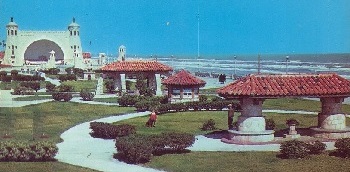
Volusia County FLGenWeb is a free genealogical site about the history of the county. We hope you find helpful clues for your research of ancestors and relatives of Volusia county.

Volusia County was established December 29, 1854. Its territory was carved from Orange County. It was named for the port of Volusia along the St. John's River on the county's western side. DeLand is the county seat.
In 1884 when the Volusia County area was separated from Orange County, river travel deigned where the
greatest population would be. The town of Volusia began as a trading post in the early 1800's as it
was situated on an Indian trail as well as being located on the eastern side of the St. Johns where
Hwy 40 crosses it. The area became a supply depot for military goods during the 1884-1885 Second
Seminole War.
It's banks made easy landing for steamboats. People disembarked, liked what they saw and stayed.
The whole of Volusia County had a population of around 600 people at its birth. The largest group
resided in the town of Volusia. The town grew and had it's own post office, one of only four in the
county. With the coming of the railroads in the 1880's the tracks didn't come through Volusia. Now
it is a small unincorporated area.
There are three theories of the meaning of the word Volusia. Timucuan Indians died out leaving
the area uninhabited in the early 1700's. The next tribe to inhabit the area were the Euchee who
migrated from South Carolina. The word might have come from their word meaning "Land of the Euchee".
It might have come from the name of a plantation along the river or it might have come from changes
in the last name of an employee of the trading post, Veluche, perhaps of French descent whose name
was pronouced Va-loo-shay. The man was so well liked that people referred to the post office as
"Veluche's Place".
During the time the British occupied Florida, a new settlement was begun in southeast Volusia
County. It was connected to St. Augustine by the Kings Road. Many of these settlers were Minorcan
and moved to St. Augustine, 70 miles north.
Another group of Indians settled in several parts of Volusia. These became the Seminole Tribe.
They were descendants of Creek's from Georgia and Alabama who would not abide by the forced
relocation instead moving to Florida. A large sugar plantation located in what became Daytona Beach
was burned by the Seminole's in the Second Seminole War (1836-1842).
Today evidence of the Timucua can be seen in various areas around Volusia. There are large shell
middens at Tomoka State Park. These are large dumps of domestic waste containing many mollusk shells
as well as tools of the time and remnants of the food the inhabitants ate. In some areas each home
had their own midden rather than utilizing a community wide one.
Source: Information compiled from commentary by Tom Schofield and Wikipedia.
Volusia County FLGenWeb ©2019 – Design by Templates in Time